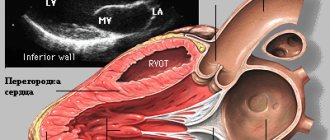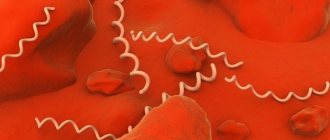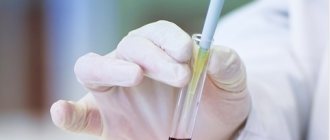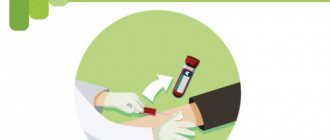Blood tests for rheumatoid factor are a primary laboratory test, a set of immunological tests for pathologies and inflammatory processes. Rheumatic tests are carried out as part of a comprehensive study of the immune system or independently. Tests help detect connective tissue diseases, rheumatoid processes and determine the state of human immunity.
The study of rheumatoid factor in the blood makes it possible to establish the fact, the degree of inflammation activity and the phase of the rheumatoid process, and to evaluate the ongoing therapeutic measures. Referral for rheumatology evaluation is necessary if there is a suspicion of rheumatoid arthritis, osteoporosis, gout, rheumatism, systemic scleroderma, ankylosing spondylitis, polymyositis/dermatomyositis, Sjogren's syndrome, osteoarthritis, lupus and other autoimmune and chronic inflammatory diseases in patients.
Why do women get rheumatoid arthritis more often than men?
Rheumatoid arthritis (RA) is a systemic connective tissue disease primarily affecting small joints of the hands and feet of an autoimmune inflammatory-erosive nature, followed by destruction (destruction) of bone and cartilage tissue. A systemic form of rheumatoid arthritis affecting internal organs is common.
It has been reliably established that this is a predominantly female disease, but the exact causes and mechanisms of its development have not been established. The main causes of rheumatoid arthritis in women and men are the same; they are complicated heredity and a viral infection. But women, unlike men, have many more additional triggering factors that provoke the development of the disease. These factors include:
- Any hormonal disorders. Determined that:
- a high concentration of female sex hormones estrogen in the blood stimulates the proliferation of connective tissue, which means a tendency to progression of the pathological process and dysfunction of the limb; and yet during pregnancy, with sufficiently high estrogen levels, RA remission often occurs;
- the disease begins mainly at the age of 40 - 45 years and older, when a woman’s hormonal levels decrease and in this case hormonal imbalance is of great importance;
- endocrine diseases - diabetes, obesity, hypothyroidism increase the risk of developing rheumatoid arthritis.
- Smoking leads to persistent narrowing of blood vessels, increasing the susceptibility to the development of rheumatoid arthritis.
The development of RA is also facilitated by the response of a woman’s immune system to infection:
- the female body more actively produces antibodies (immunoglobulins - Ig) in response to the introduction of infection; why this happens has not been established; at the same time, Ig class M - rheumatoid factor - is especially actively produced;
- the balance of certain types of T-lymphocytes responsible for cellular immunity is disrupted; the number of T-helpers (helper cells, T4 or CD4+, they help other cells destroy the infection) increases, while the number of T-suppressors (cells that suppress the activity of immune cells so that they do not destroy body tissue, T8 or CD8+) remains the same; this leads to the development of autoimmune reactions.
Due to the increased amount of adrenal hormone cortisol in the blood, women also experience increased (compared to men) production of cytokines (messenger molecules) that support inflammation. These are interleukin 1 (IL-1) and tumor necrosis factor alpha (TNF-alpha). At the same time, the amount of anti-inflammatory cytokines does not increase, which helps maintain a long-term inflammatory process.
A woman can get sick at any age. In girls, adolescents and young women, the seronegative form of the disease is more common, when rheumatoid factor is not detected in the blood (RF - IgM antibodies to one's own tissues). In middle and old age, a seropositive form of the disease develops more often, in which high titers of RF are detected in the blood. But with early menopause, starting before age 50, women often experience seronegative rheumatoid arthritis.
Results of rheumatic factor analysis
Based on the results of the analysis, we can conclude that the rheumatic factor increases:
- slightly increased – from 15 to 50 IU/ml;
- elevated – 50-100 IU/ml;
- significantly increased – above 100 IU/ml.
By the amount of rheumatic factor, the severity of the autoimmune process can be determined.
The analysis is very important, since its result will show the presence and intensity of autoimmune processes and will allow you to quickly select the most effective treatment.
Symptoms
Symptoms of rheumatoid arthritis in women
The more common seropositive form of rheumatoid arthritis (SPRA) develops gradually in women. This is a typical course of RA in middle-aged and elderly women.
The first symptoms of SPRA, when they appear, you should consult a doctor:
- morning stiffness that persists for half an hour or more;
- mild swelling and tenderness in three or more small joints;
- the pathological process begins from the metacarpophalangeal joints of the hands or from the metatarsophalangeal joints of the feet; this is confirmed by a positive transverse compression test - pain when squeezing the hand or foot.
Clear signs of SPRA are a reason to consult a doctor immediately!
Joint inflammatory processes progress, joint pain becomes constant, debilitating, stiffness in the morning increases and lasts at least an hour. New small and even large joints may be involved in the process. The lesion remains symmetrical.
A woman’s body temperature may rise, but more often it is a slight (low-grade) rise, and signs of damage to other organs and systems appear. The risk of developing contractures (reduced joint mobility) and ankylosis (complete immobility of joints) increases.
Extra-articular symptoms (not always found, but require immediate medical attention):
- rheumatoid nodules on the skin in the area of the affected joints;
- enlarged, painless lymph nodes;
- decrease in muscle volume;
- inflammation of blood vessels - vasculitis in the form of the appearance of pinpoint areas of necrosis around the nail bed;
- damage to the heart and lungs, accompanied by shortness of breath;
- kidney damage with impairment of their function;
- enlarged liver and spleen;
- low hemoglobin, anemia.
Possible complications - require hospital treatment:
- necrosis of the cartilage of joint bones - arthritis can cause such complications very often as the process progresses;
- loss of calcium in bone tissue (osteoporosis), bone fragility;
- habitual fractures, dislocations and subluxations in the affected joints;
- compression of peripheral nerves by inflamed tissues - tunnel syndromes;
- amyloidosis – deposition of amyloid in the internal organs, which leads to disruption of their function;
- exhaustion.
All the obvious symptoms of rheumatoid arthritis in women
Symptoms of seronegative rheumatoid arthritis in women:
- the onset of this disease is subacute or acute with fever, malaise, weakness, headache, muscle pain;
- swelling and pain in one or two large joints (knees, elbows, etc.);
- at the beginning of the disease, the lesions are asymmetrical, but over time, symmetrical lesions of small joints may occur;
- There is no rheumatoid factor in the blood.
Markers of osteoporosis
Laboratory diagnosis of osteoporosis includes tests for the following indicators:
- calcitocin is a hormone that maintains a constant level of calcium in bone tissue, preventing its destruction,
- parathyroid hormone - indicates the effectiveness of calcium metabolism, controls the flow of calcium and phosphate from the bones into the blood,
- Deoxypyridinoline (DPID) is the most specific marker of bone destruction; is the main material of collagen cross-links,
- Osteocalcin is a key non-collagenous bone protein; its content reflects the metabolic activity of osteoblasts,
- b-Cross Laps is a degradation product of type 1 collagen; an increase in its concentration indicates an acceleration of the process of collagen destruction.
A blood test is performed to diagnose osteoporosis. A comprehensive assessment of several indicators allows you to accurately diagnose and identify the causes of osteoporosis.
The disease is characterized by a violation of the structure of bone tissue, a decrease in bone mass. Accompanied by an increase in the activity of osteoclasts - cells that destroy bones. Osteoblasts - creating cells - do not fill the resulting cavities, as a result of which the tissue is not restored. Several functional techniques are used for diagnosis:
- bone densitometry,
- radioisotope bone scan,
- trepanobiopsy.
Laboratory diagnostics is the final stage of examination. It allows you to confirm the doctor’s assumptions and identify the conditions for the course of the disease.
You can get tested at any office of the Health Laboratory CDC. It takes about 7 days to diagnose osteoporosis. We will inform you additionally when the results are ready.
Stages
Any form of arthritis has serious complications, so you should not delay treatment.
See how easily the disease can be cured in 10-12 sessions.
There are 4 clinical stages of the development of rheumatoid arthritis in women:
- Initial
– lasts for 6 months, the first signs are somewhat erased, but remain constant; sometimes there is an acute onset; - Early
– the development of pathology in the first year of the disease, the symptoms appear clearly. - Expanded
– the first two years of the disease, the signs are bright, the course is progressive, possible impairment of joint mobility. - Neglected
– more than two years, symptoms of joint deformation and persistent impairment of limb function appear, which becomes a cause of disability.
From stage to stage, there is a clear tendency for arthritis to progress in the absence of treatment. Therefore, it is very important to promptly identify the symptoms of rheumatoid arthritis in women and immediately begin treatment.
Preparation
A biochemical blood test requires special preparation.
- You need to take the test strictly on an empty stomach, after 8-12 hours of fasting, you can only drink still water.
- You should not change your diet for 3 days, but try to exclude fatty, spicy and fried foods.
- It is recommended to stop playing sports 3 days before the test.
- You should take a biochemical test in the morning, from 7 to 11 am.
- You should stop taking medications 3 days in advance; if this is not possible, notify your doctor.
- It is advisable to take tests in the same laboratory
Diagnostics
The following diagnostic criteria for rheumatoid arthritis in women exist:
- Clinical
: characteristic symptoms of RA. - Laboratory
:- general blood test - acceleration of ESR, decrease in hemoglobin;
- biochemical analysis - the appearance of C-reactive protein (CRP) - a sign of inflammation;
- immunological analysis - the presence in the blood of rheumatoid factor, antibodies to peptides containing the amino acid citrulline (ACCP), cytokines IL1 and TNF-alpha. Women's blood is also tested for hormones to rule out diseases that support the autoimmune inflammatory process.
- Instrumental
:- X-ray – signs of progressive arthritis and joint damage;
- Ultrasound - signs of damage to articular and periarticular tissues;
- MRI – detection of articular changes in the pre-erosive period, already 4 weeks after the onset of the disease.
Cardiac markers
Cardiac markers are specific protein compounds found in muscle tissue. In heart disease, cells are damaged and released enzymes enter the blood. A large number of amino acids in the blood may also indicate the destruction of skeletal muscles and hidden bleeding.
Tests for cardiac markers are prescribed:
- in preparation for surgery under general anesthesia,
- patients with complaints of heart pain,
- for differential diagnosis of cardiovascular diseases.
Patients admitted with suspected heart attack are tested for myoglobin, troponin I and creatine kinase. An increase in the concentration of these proteins in the blood begins within a few hours after damage to the heart muscle.
If systemic heart disease or destruction of the vascular wall is suspected, a blood test is performed for the cardiac marker homocysteine. An increase in amino acid concentration indicates damage to the vascular epithelium. Indicators below normal are a sign of a lack of folic acid and B vitamins in the body.
Patients with ischemia or acute coronary syndrome should be regularly tested for troponin I. This specific protein is present only in the heart muscle and is released when its cells are damaged at the slightest level. An increase in the concentration of a cardiac marker indicates the risk of developing myocardial infarction in the near future.
You can undergo any test in our laboratory without a doctor’s prescription. All you need to do is make an appointment by phone. Test results for cardiac markers will be ready in one to five business days, depending on the number of indicators. You can obtain the data at the office where the survey was conducted or by email.
Treatment
Treatment of rheumatoid arthritis in women
If signs of rheumatoid arthritis appear in a woman, treatment should be prescribed immediately after diagnosis, taking into account the data of the examination. Prescribed:
- a diet with sufficient animal protein and calcium - dairy products, lean meat and fish, vegetables, fruits, cereals; spicy foods and sweets are excluded;
- correct daily routine with alternating sleep and wakefulness, eliminating stress;
- drug therapy and traditional methods of treating rheumatoid arthritis in women;
- physiotherapeutic procedures, physical therapy (physical therapy), massage;
- methods of gravitational blood surgery - hemosorption, plasmapheresis;
- orthopedic correction methods;
- surgical treatment of rheumatoid arthritis in women.
Drug therapy
Treatment of rheumatoid arthritis in women is carried out comprehensively, with the appointment of symptomatic and basic therapy. Drugs of these two groups are prescribed simultaneously:
- symptomatic remedies can quickly alleviate a woman’s condition by eliminating swelling and pain; are prescribed in the shortest possible courses;
- basic drugs suppress the mechanism of disease development; they have been accepted for years.
Symptomatic treatment of rheumatoid arthritis in women
To reduce the most severe manifestations of rheumatoid arthritis, medications from the group of nonsteroidal anti-inflammatory drugs (NSAIDs) are primarily prescribed. Most of them eliminate tissue swelling and associated pain. One of the first and most effective NSAIDs is Diclofenac. It is prescribed in the form of injections, rectal suppositories, oral tablets, ointments and gels. The disadvantage of the drug is side effects: gastric ulcers and decreased blood clotting.
More modern drugs of this group - Nimesulide, Meloxicam, with high efficiency, have almost no such side effects.
Symptomatic treatment of rheumatoid arthritis in women
Medicines from the group of glucocorticoid hormones (Betamethasone, Prednisolone, etc.) relieve swelling and pain in arthritis even better. But their use in women is associated with the risk of stimulating the synthesis of pro-inflammatory cytokines IL-1 and TNF-alpha, so drugs of this series are prescribed with caution, only when indicated and in short courses. They also have many serious side effects.
As soon as the pain decreases, symptomatic therapy is removed. In order to reduce the dosage of drugs from these groups, they are often prescribed in combination with folk remedies and homeopathic medicines:
- celery juice
- prescribed 20 ml three times a day 30 minutes before meals as an analgesic and anti-inflammatory agent; course of treatment 1.5 months; - Goal T
is a homeopathic drug, prescribed in the form of intramuscular injections, lozenges and ointments; relieves joint inflammation and pain.
Only a doctor can prescribe folk and homeopathic remedies. Taking them on your own is absolutely ineffective; moreover, it can accelerate the progression of the disease.
Basic therapy
Basic therapy drugs are also divided into two large groups - synthetic and biological. Synthetic ones include Methotrexate, Sulfasalazine, Lkflunomide. They suppress the increased reactivity of the immune system and have an anti-inflammatory effect. Most often, the time-tested Methotrexate is prescribed, but at the same time the content of folic acid in the body decreases, so it must be prescribed simultaneously with Methotrexate.
Biological basic drugs include drugs that specifically suppress educational cytokines. These drugs are especially effective in the treatment of female forms of rheumatoid arthritis, since cytokines are the main cause of a long-term inflammatory process. The use of Infliximab and Adalimumab, drugs containing antibodies to TNF-alpha, is especially effective in women. If IL-1 cytokines predominate in a woman’s blood, then Anakinra, which contains antibodies to this cytokine, is prescribed.
Additional therapeutic procedures
These methods include:
- physiotherapeutic procedures
– enhance the effectiveness of drug therapy in women suffering from arthritis; - plasmapheresis and hemosorption
- used for severe rheumatoid arthritis in women to cleanse the blood of toxic products; - Exercise therapy and massage
prevent the development of severe ankylosis (immobility of joints); courses are conducted only as prescribed by a doctor and under the supervision of a physical therapy instructor; doing exercises on your own can cause irreparable harm to the body; - orthopedic correction methods
- the use of special devices that hold the limb in the correct position, as a result of which the process of deformation of the limbs is stopped; - surgical operations
- endoprosthetics (in case of a high degree of damage to the joint, replacing it with an artificial one).
Treatment of rheumatoid arthritis in women in our clinic
Treatment of rheumatoid arthritis in women in the clinic
At the Moscow clinic “Paramita” they approach the treatment of female forms of rheumatoid arthritis with special care. To do this, a comprehensive examination of the patient is carried out, identifying hormonal disorders and concomitant diseases that contribute to the development and maintenance of the autoimmune inflammatory process. Correction of these disorders is necessarily part of the complex therapy of a woman suffering from rheumatoid arthritis.
We combine proven techniques of the East and innovative methods of Western medicine.
Read more about our unique method of treating arthritis
The doctors of our clinic have at their disposal a wide range of the latest European and traditional oriental healing methods. In our practice we use:
- drug therapy, combining the administration of the most effective modern drugs, medicinal herbs and homeopathic remedies; this allows you to quickly relieve pain and significantly reduce the drug load on the patient’s body;
- physiotherapeutic procedures - their skillful combination with drug therapy according to modern regimens leads to a rapid improvement in a woman’s condition;
- kinesitherapy, taping, exercise therapy and massage courses are selected strictly individually, preventing the development of ankylosis and joint deformities;
- PRP therapy is a unique modern method of stimulating the regenerative abilities of tissues by introducing the patient’s own platelets, processed using a special technique;
- reflexology (RT) - influence on acupuncture points (AP) on the human body, reflexively connected with various organs and systems; our specialists have been trained in RT in China and Tibet, they are proficient in all methods of RT - acupuncture, cauterization with wormwood cigarettes, acupressure, etc.; in skillful hands, the effectiveness of RT can be equal to the effectiveness of drug therapy;
- pharmacopuncture – introduction of modern medicines into AT; one of the most effective ways to treat RA.
This approach to the treatment of rheumatoid arthritis in women allows patients to constantly be in a state of remission. They regularly undergo courses of maintenance therapy in our clinic, lead an active lifestyle, forgetting about painful exacerbations and the prospect of disability.
How to achieve lasting remission
In order to forget about exacerbations of rheumatoid arthritis, you need to:
- Healthy food;
- move more, do exercise therapy, swim, walk;
- get rid of stress, overload at work and at home, heavy physical work;
- no smoking;
- promptly identify and treat hormonal disorders;
- regularly carry out courses of maintenance treatment prescribed by your doctor.
Rheumatoid arthritis in women is treated at any stage. The specialists of the Moscow Paramita clinic know this well.
Literature:
- Nasonov EL, Karateev DE, Balabanova RM. Rheumatoid arthritis. In the book: Rheumatology. National leadership. Ed. E. L. Nasonova, V. A. Nasonova. Moscow: GEOTAR-Media; 2008. pp. 290–331.
- Folomeeva O. M., Galushko E. A., Erdes Sh. F. Prevalence of rheumatic diseases in adult populations of Russia and the USA. Scientific and practical rheumatology. 2008;46(4):4-13. DOI:10.14412/1995-4484-2008-529.
- Leandro G, Mangia A, Hui J, et al. Relationship between steatosis, inflammation, and fibrosis in chronic hepatitis C: a meta-analysis of individual patient data. Gastroenterology 2006;130(6):1636-42.
- Rubbia-Brandt L, Quadri R, Abid K, et al. Hepatocyte steatosis is a cytopathic effect of hepatitis C virus genotype 3. J Hepatol 2000;33(1):106-15.
- Hezode C, Roudot-Thoraval F, et al. Different mechanisms of steatosis in hepatitis C virus genotypes 1 and 3 infections. J Viral Hepat 2004;11(5):455-8.
Themes
Joints, Pain, Treatment without surgery Date of publication: 04/14/2020 Date of update: 03/12/2021
Reader rating
Rating: 4.67 / 5 (3)










